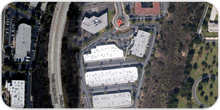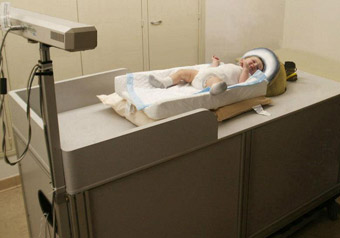 Electrical measurements of physiological potentials are well established in clinical diagnostics. The flow of an electrical current creates a corresponding magnetic field. Thus bioelectric activity will generate biomagnetic fields. These fields can be detected with Tristan SQUID magnetometers. For many of the classical electrical techniques such as ECG and EEG, there are corresponding magnetic techniques (magnetocardiography or MCG and magnetoencephalography or MEG). In some cases (magnetopneumography, hepatic iron store measurements, intestinal ischemia, peripheral nerve and muscle activity), there is no corresponding electrical technique and biomagnetic measurements offer unique measurement capabilities. Unlike CT or MRI imaging which yield structural information, biomagnetic measurements offer real-time functional imaging.
Electrical measurements of physiological potentials are well established in clinical diagnostics. The flow of an electrical current creates a corresponding magnetic field. Thus bioelectric activity will generate biomagnetic fields. These fields can be detected with Tristan SQUID magnetometers. For many of the classical electrical techniques such as ECG and EEG, there are corresponding magnetic techniques (magnetocardiography or MCG and magnetoencephalography or MEG). In some cases (magnetopneumography, hepatic iron store measurements, intestinal ischemia, peripheral nerve and muscle activity), there is no corresponding electrical technique and biomagnetic measurements offer unique measurement capabilities. Unlike CT or MRI imaging which yield structural information, biomagnetic measurements offer real-time functional imaging.
Biomagnetic measurements provide a number of advantages compared to electrical measurements:
- Biomagnetism is non-invasive. The detection system does not contact the subject. The non-invasive nature of biomagnetism makes it an inherently safe procedure and minimizes subject preparation time.
- Insulating barriers such as the skull, varying layers of tissue, anatomical open spaces, do not attenuate or distort magnetic fields. Electrical signals are distorted by the varying resistive layers between the signal source and the surface skin.
- SQUID magnetometers measure the vector component(s) of the magnetic field. Thus localization is much easier than with electrical measurements, which only measure scalar voltages.
- Magnetic measurements can be made for which there are no electrical analogs. These include measurements of static magnetic fields, measurements of the magnetic susceptibility and measurements where an invasive procedure is not possible (e.g., fetal cardiography).
- Because of the superconducting nature of SQUID measurements, true dc response and flat phase response are available.
Instrumentation
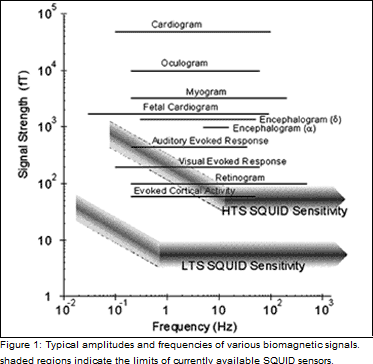 The strength of biomagnetic signals is many orders of magnitude smaller than even the earth’s magnetic field, which is 1/2 Gauss or 50 microTesla. The signal strengths associated with biomagnetism (Fig. 1) require the use of extremely sensitive detection systems. The units in this figure are femtoTesla, 1 fT = 10-15 Tesla.
The strength of biomagnetic signals is many orders of magnitude smaller than even the earth’s magnetic field, which is 1/2 Gauss or 50 microTesla. The signal strengths associated with biomagnetism (Fig. 1) require the use of extremely sensitive detection systems. The units in this figure are femtoTesla, 1 fT = 10-15 Tesla.
The components of a SQUID magnetometer (Fig. 2) typically consist of the following: a detection coil, which senses changes in the external magnetic field and transforms them into an electrical current; an input coil which transforms the resulting current into a magnetic flux in the SQUID sensor; electronics which transform the applied flux into a room temperature voltage output; and acquisition hardware and software for acquiring, storing and analyzing data. Both the SQUID amplifier and the detection coils are superconducting devices. Thus some type of refrigerant (liquid helium or liquid nitrogen) or refrigeration device (cryocooler) is needed to maintain the SQUID and detection coil in the superconducting state. Additional signal conditioning electronics may be needed to improve signal-to-noise.

The SQUID sensor and electronics package can be considered as a black box that acts like a magnetic field-to-voltage converter and amplifier with extremely high gain. In addition, it offers extremely low noise, high dynamic range, excellent linearity, flat phase response and a bandwidth that can extend from dc to beyond 100 kHz, capabilities that no other single sensor offers.
The type of SQUID sensor and detection coil configuration is dependent on what is to be measured. Figure 1 also shows the capability of both low temperature (requiring liquid helium temperatures, and referred to as LTS) and high temperature (requiring liquid nitrogen temperatures, and referred to as HTS) SQUID magnetometers. Tristan biomagnetic measurement systems make use of either Tristan’s LSQ/20 LTS dc SQUID sensor or the HTM-3 HTS dc SQUID sensor. The input coil for an LTS SQUID is normally fabricated from flexible superconducting NbTi wire. The inherent anisotropic nature of HTS SQUIDs requires that the input coils be planar.
Another factor to be considered is the detection coil configuration. Conceptually, the easiest input circuit to consider for detecting changes in magnetic fields is a pure magnetometer (Fig. 2). However, magnetometers are extremely sensitive to all magnetic signals in the environment. This may be acceptable if one is measuring ambient fields. However, if the magnetic signal of interest is weak, then environmental magnetic interference may prevent measurements. If the signal source is close to the detection coil, then a gradiometer coil may allow a weak signal to be measured. Figure 3 shows the relative noise rejection for 1st and 2nd derivative gradiometers. The figure insert shows a first order gradiometer, consisting of two coils connected in series but wound in opposite senses, and separated by a distance “b”, called the gradiometer baseline. A uniform magnetic field (e.g., from a distant environmental source) would couple equal but opposite quantities of flux into the two coils, resulting in zero net flux in the gradiometer, or zero signal. However, signal sources that are close to the lower coil (relative to the baseline, or separation between coils) would couple significantly more flux into the lower coil than into the upper coil; this would result in a net flux in the gradiometer and hence the signal would be detected.
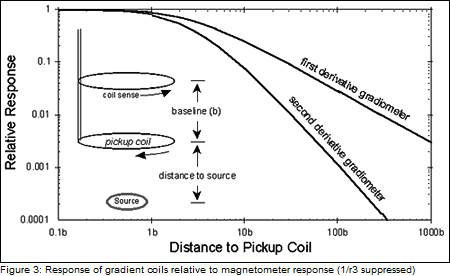 For objects objects that are close (relative to the gradiometer baseline), the gradiometer acts as a pure magnetometer, while rejecting more than 99% of the magnetic signals coming from distant objects. In essence, the gradiometer acts as a “compensated” magnetometer.
For objects objects that are close (relative to the gradiometer baseline), the gradiometer acts as a pure magnetometer, while rejecting more than 99% of the magnetic signals coming from distant objects. In essence, the gradiometer acts as a “compensated” magnetometer.
Normally, SQUID magnetometers (and gradiometers) map the axial (Bz) component of the magnetic field. Obviously, using three sensors, it is possible to monitor all three vector components of the magnetic field. Additional channels of SQUID sensors can be used to provide reference channels for electronic balancing. Portions of the reference magnetometer responses are summed electronically with the detection coil(s) output to reject common mode signals from distant noise sources. Electronic balancing can be used to create a virtual HTS axial gradiometer from two HTS magnetometers.
Series 600 LTS Systems
Model 601 Single Channel Gradiometer System
The 601 is a single channel LTS (liquid helium) SQUID gradiometer system. Its components consist of a Cryogenic Probe with liquid helium level sensor, a 1st order axial (dBz/dz) detection coil, iMAG® LTS SQUID and electronics (1 channel) and a Model BMD-9 Liquid Helium Dewar. With a 1 cm detection coil, sensitivities surpassing 10 fT/√Hz are readily achievable. The BMD-9 dewar allows the detection coils to be placed within 10 mm of room temperature. System components:
- 1st order axial detection coil, nominal 1 cm diameter, 2% balance
- Cryogenic Probe with liquid helium level sensor
- Model LSQ/20 LTS dc SQUID
- Model BMD-9 Liquid Helium Dewar
- Model iMC-303 Cryogenic Control Unit
- Model iFL-301-L Flux-Locked Loop
- Model CC-6 six meter fiber-optic composite cable
- Manual and accessory pack
Model 603 Three Channel Gradiometer
The 603 is a three channel system with the detection coils oriented orthogonally. To reduce external noise, the coils are configured as one axial and two planar gradiometers (dBz/dz, dBx/dz, dBy/dz). With 1 cm detection coils, sensitivities better than 10 fT/√Hz are nominal. The 603 can also be ordered with three axial detection coils. System components:
- Three 1st order detection coils (dBz/dz, dBx/dz, dBy/dz)
- nominal 1 cm diameter, 2% balance
- Cryogenic Probe with liquid helium level sensor
- 3 Model LSQ/20 LTS dc SQUIDs
- Model BMD-9 Liquid Helium Dewar
- Model iMC-303 Cryogenic Control Unit
- 3 Model iFL-301-L Flux-Locked Loops
- 3 Model CC-6 six meter fiber-optic composite cables
- Manual and accessory pack
Model 606 Noise Cancellation Gradiometer
 The 606 (Fig. 4) is an extension of the Model 603 with the addition of three channels (Bx, By, Bz) for electronic noise cancellation. System noise is dependent on the electronic noise cancellation implementation, but <10 fT/√Hz is expected. The 606 can also be ordered with six axial detection coils.
The 606 (Fig. 4) is an extension of the Model 603 with the addition of three channels (Bx, By, Bz) for electronic noise cancellation. System noise is dependent on the electronic noise cancellation implementation, but <10 fT/√Hz is expected. The 606 can also be ordered with six axial detection coils.
Series 700 HTS Systems
For biomagnetic measurements not requiring the sensitivities of LTS systems, Tristan offers systems based on Tristan’s HTM HTS (liquid nitrogen temperature) SQUID sensors, which can operate in ambient and millitesla fields.
Model 701 HTS Magnetometer
The 701 is a compact single channel magnetometer system. It includes iMAG® electronics and a 7.6 cm diameter liquid nitrogen dewar with a hold time > 16 hours. The NLD-310 dewar allows the detection coil to be within 5 mm of room temperature.
Model 703 Three Channel HTS Magnetometer
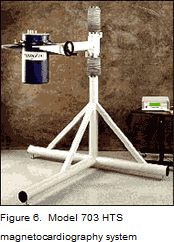 The 703 is a moderate sized (12.7 cm diameter) three channel magnetometer system. The detection coils can be configured axially or orthogonally (Bx, Bx, Bx) or for electronic noise cancellation. A custom version of the 703 (Fig. 6) was used to make the first unshielded measurements of magnetocardiograms using an HTS system.
The 703 is a moderate sized (12.7 cm diameter) three channel magnetometer system. The detection coils can be configured axially or orthogonally (Bx, Bx, Bx) or for electronic noise cancellation. A custom version of the 703 (Fig. 6) was used to make the first unshielded measurements of magnetocardiograms using an HTS system.
Options for the Series 700 HTS magnetometers include tailed dewars, modified inserts that allow ±90° dewar orientation, an adjustable tail to permit < 5 mm tail gaps, external magnets, additional sensors to form electronic gradiometers and LN2 level readouts.
Custom Biomagnetic Systems
Choose from existing designs, modified versions of standard systems, or fully customized systems for your specific needs. Tristan will supply individual components or complete systems.
Examples of custom systems include a 29 channel Intestinal Ischemia gradiometer, a dual cryostat (magnet and dual gradiometer) system for Magnetopneumography, and multiple other systems for biomagnetic measurements.
Be it standard or custom, many choices are available. We can supply systems with:
- High channel counts
- Coil-in vacuum construction
- Separate superconducting polarizing magnets and detection magnetometers for magnetopneumography
- Orthogonally oriented (Bx,By, Bz) detection coils
- Integrated superconducting magnets
- Reference channels for noise cancellation
- Software for data analysis from basic LabVIEW™ drivers to sophisticated magnetic dipole and current dipole fits.
From basic single-channel magnetometer systems to multi-channel instruments for specific applications, Tristan offers a variety of fully configured systems for biomagnetic measurements
Applications
- Magnetoencephalography
- Magnetocardiography
- Fetal Magnetocardiography
- Peripheral Nerve and Muscle Activity
- Liver Iron (hepatic iron stores) Assessment
- Intestinal Ischemia
- Magnetopneumography
- Single Neuron Activity Studies
Technologies Available to Satisfy Your Applications
Advanced Josephson Junction Technology
- Liquid Helium (LTS) and Liquid Nitrogen (HTS) SQUIDs
Complex Custom Design Coil Arrays
- 2 mm to 3 cm detection coils
- magnetometers and gradiometers (axial or planar; symmetric or asymmetric), higher order gradiometers
- orthogonal coils to measure all three vector components (Bx, By, Bz)
Custom Dewars and Cryocooled Systems
- adjustable tails coil-to-subject distances as small as 2 mm
- compact hand-held to whole-head dewars
- ultra-low boil-off dewars, cryogen free and cryocooler assisted
Magnets and Magnetic Shielding
- integral superconducting magnets for ac (milliTesla) and dc (Tesla) susceptibility measurements
- separate polarizing magnet cryostats for magnetopneumography
- coil-sized magnetic shields to full sized rooms
Custom Electronics and Software
- electronic noise cancellation hardware and software
- data acquisition hardware and software

